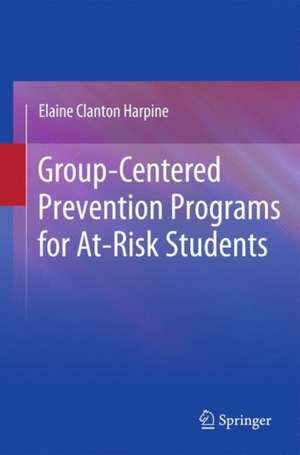Group-Centered Prevention Programs for At-Risk Students
Autor Elaine Clanton Harpineen Limba Engleză Hardback – 24 noi 2010
Group-Centered Prevention Programs for At-Risk Students focuses on the development of such a week-long prevention program, and provides professionals with step-by-step directions to create their own program. It also focuses on the use of group-centered interventions as an opportunity to prevent at-risk behaviors as a means of correcting or changing dysfunctional behavior.
This highly readable volume addresses such challenging issues as:
- Using self-reflection to teach writing skills.
- Increasing interpersonal interaction while honing etiquette.
- Enhancing group acceptance and reading comprehension.
- Rebuilding self-efficacy by increasing word recognition and decoding skills.
| Toate formatele și edițiile | Preț | Express |
|---|---|---|
| Paperback (1) | 634.49 lei 43-57 zile | |
| Springer – 9 oct 2014 | 634.49 lei 43-57 zile | |
| Hardback (1) | 640.71 lei 43-57 zile | |
| Springer – 24 noi 2010 | 640.71 lei 43-57 zile |
Preț: 640.71 lei
Preț vechi: 753.77 lei
-15% Nou
Puncte Express: 961
Preț estimativ în valută:
122.62€ • 127.54$ • 101.23£
122.62€ • 127.54$ • 101.23£
Carte tipărită la comandă
Livrare economică 14-28 aprilie
Preluare comenzi: 021 569.72.76
Specificații
ISBN-13: 9781441972477
ISBN-10: 1441972471
Pagini: 176
Ilustrații: XX, 155 p.
Dimensiuni: 155 x 235 x 23 mm
Greutate: 0.43 kg
Ediția:2011
Editura: Springer
Colecția Springer
Locul publicării:New York, NY, United States
ISBN-10: 1441972471
Pagini: 176
Ilustrații: XX, 155 p.
Dimensiuni: 155 x 235 x 23 mm
Greutate: 0.43 kg
Ediția:2011
Editura: Springer
Colecția Springer
Locul publicării:New York, NY, United States
Public țintă
ResearchCuprins
Preface.- Introduction.- Acknowledgments.- Easy Reference Guide to Group-Centered Interventions.- About the Author.- Organizing a New Group.- Designing Group-Centered Interventions.- Identifying the Needs of the Group.- Using Group Process as an Agent of Change.- Group Process and Motivation.- The Role of Interaction in a Group.- Self-Efficacy: The Learning Component in Schools.- Group Cohesion: The Therapeutic Factor in Groups.- Back to the Classroom.
Recenzii
“Group-Centered Prevention Program for At-Risk Students builds on Clanton Harpine’s first book on this general topic of groups in schools, Group Interventions in Schools: Promoting Mental Health for At-Risk Children and Youth, which Andy Horne reviewed in the July 2009 issue of this newsletter (pp. 22–23). Please refer to the contents of that review because they highlight and set the stage for much of what continues, by design of the author, in this new book I am reviewing. Where, among other emphases, the first book introduced the topic of group-centered interventions within schools, this one explicates it by focusing on groups used for the prevention of at-risk problems faced by students in the schools (as well as a way to correct existing problems).
In addition, the emphasis of this book on group approaches to prevention is fully consistent with one of the major initiatives of the Society for Group Psychology and Group Psychotherapy. Beginning with a set of task force recommendations on this topic in 2000, the Society has dedicated its APA convention theme to this area (2009) and its journal, Group Dynamics: Theory, Research, and Practice published a special issue (2010, Volume 14, Number 3) addressing the group-prevention nexus. I was involved in all these efforts, for example, co-editing with Dr. Clanton Harpine the journal special issue mentioned above. So, fair disclosure holds I indicate that I may not be a completely objective reviewer of this book which I think so clearly explicates the ongoing group-prevention emphasis that the Society (and the Association for Specialists in Group Work) has endorsed and which I, along with an increasing number of other psychologists, feel so strongly about.
Consider the title of this new book for a moment. How does an author organize in one succinctly and well-written book the very large andcomplex topics of: “Group-Centered,” “Prevention Program, “and “At-Risk Students”? This is an ambitious project at the start, where diverse sets of concepts must be juggled successfully and it is not for the faint-of-heart. This level of challenge may explain, at least in part, why the field is dominated with a much more familiar line of scholarly work, practice, and research: “Individual-Centered,” “Remedial Program,” and “Problem Students” (not to imply this line of inquiry and practice is unimportant or easy).
Clanton Harpine pulls this grand project off with aplomb. Her new book is conceptually sound, research-based, jam-packed with practical applications, and is written in a scholarly and readable style. The latter quality is especially apropos because the on-going applied focus of her book is on an intensive 10-hour prevention program based on group approaches she has developed, called Camp Sharigan, which uses reading as the means for exerting preventive effects. Because her group-based prevention program targets school-age children, and because reading is an essential life skill for children (and people of all ages in our society), it makes perfect sense to build a group-based prevention program around reading, which can be tackled in class, after class, during summer programs, and in community-based efforts. As Clanton Harpine indicates in a critically important point, “Camp Sharigan is not just a reading program. Reading is the intervention to change behavior and strengthen mental wellness” (p. 56). As an aside, I’ve always been attracted to the potential of using indirect approaches for improving mental health, especially in prevention programs, by involving participants in main-line activities such as reading or exercise or volunteer work projects, with mental health guidance and applications intentionally and integrally attached.
Why does this “readingprogram” work? A key reason, which will be of no surprise to readers of this newsletter, is because of the interactive psychoeducational group processes that run through it by design. As the author points out, group interaction is essential for promoting learning and change. She goes further by saying, “Direct instruction or lecture is never included in a group-centered prevention program” and that “group interaction and group cohesion are built into every group-centered prevention program (p. 49).
This book may hold special value for those who want to apply or adapt the group-centered prevention principles that are presented. This is so because Clanton Harpine has taken the extra step of providing program development and evaluation tools that can be used by readers to help shape similar projects of their own. This is another unique feature of this book, taking theory and practice to a deeper level by assisting those interested to convert into action the ideas that may be inspired or at least stimulated by the many excellent applications about which they are reading.
Finally, I find little to criticize in this book and much more to praise. This is a book full of rich examples that is supported by relevant theory and research. It will be of direct help for those who themselves wish to develop group-centered prevention programs aimed at at-risk students and of general assistance to those who are interested in developing such programs for other populations. For all readers of this Newsletter and members of our Society, tying our group perspective and skills to prevention goals and programs is the next big step awaiting us. Doing so successfully will help broaden our impact, contributing to healthier people and settings. Thanks to Elaine for providing an excellent source to help guide this needed initiative.”
The Group Psychologist, April 2011, Vol. 21No. 1
Reviewed by Robert K. Conyne, University of Cincinnati
In addition, the emphasis of this book on group approaches to prevention is fully consistent with one of the major initiatives of the Society for Group Psychology and Group Psychotherapy. Beginning with a set of task force recommendations on this topic in 2000, the Society has dedicated its APA convention theme to this area (2009) and its journal, Group Dynamics: Theory, Research, and Practice published a special issue (2010, Volume 14, Number 3) addressing the group-prevention nexus. I was involved in all these efforts, for example, co-editing with Dr. Clanton Harpine the journal special issue mentioned above. So, fair disclosure holds I indicate that I may not be a completely objective reviewer of this book which I think so clearly explicates the ongoing group-prevention emphasis that the Society (and the Association for Specialists in Group Work) has endorsed and which I, along with an increasing number of other psychologists, feel so strongly about.
Consider the title of this new book for a moment. How does an author organize in one succinctly and well-written book the very large andcomplex topics of: “Group-Centered,” “Prevention Program, “and “At-Risk Students”? This is an ambitious project at the start, where diverse sets of concepts must be juggled successfully and it is not for the faint-of-heart. This level of challenge may explain, at least in part, why the field is dominated with a much more familiar line of scholarly work, practice, and research: “Individual-Centered,” “Remedial Program,” and “Problem Students” (not to imply this line of inquiry and practice is unimportant or easy).
Clanton Harpine pulls this grand project off with aplomb. Her new book is conceptually sound, research-based, jam-packed with practical applications, and is written in a scholarly and readable style. The latter quality is especially apropos because the on-going applied focus of her book is on an intensive 10-hour prevention program based on group approaches she has developed, called Camp Sharigan, which uses reading as the means for exerting preventive effects. Because her group-based prevention program targets school-age children, and because reading is an essential life skill for children (and people of all ages in our society), it makes perfect sense to build a group-based prevention program around reading, which can be tackled in class, after class, during summer programs, and in community-based efforts. As Clanton Harpine indicates in a critically important point, “Camp Sharigan is not just a reading program. Reading is the intervention to change behavior and strengthen mental wellness” (p. 56). As an aside, I’ve always been attracted to the potential of using indirect approaches for improving mental health, especially in prevention programs, by involving participants in main-line activities such as reading or exercise or volunteer work projects, with mental health guidance and applications intentionally and integrally attached.
Why does this “readingprogram” work? A key reason, which will be of no surprise to readers of this newsletter, is because of the interactive psychoeducational group processes that run through it by design. As the author points out, group interaction is essential for promoting learning and change. She goes further by saying, “Direct instruction or lecture is never included in a group-centered prevention program” and that “group interaction and group cohesion are built into every group-centered prevention program (p. 49).
This book may hold special value for those who want to apply or adapt the group-centered prevention principles that are presented. This is so because Clanton Harpine has taken the extra step of providing program development and evaluation tools that can be used by readers to help shape similar projects of their own. This is another unique feature of this book, taking theory and practice to a deeper level by assisting those interested to convert into action the ideas that may be inspired or at least stimulated by the many excellent applications about which they are reading.
Finally, I find little to criticize in this book and much more to praise. This is a book full of rich examples that is supported by relevant theory and research. It will be of direct help for those who themselves wish to develop group-centered prevention programs aimed at at-risk students and of general assistance to those who are interested in developing such programs for other populations. For all readers of this Newsletter and members of our Society, tying our group perspective and skills to prevention goals and programs is the next big step awaiting us. Doing so successfully will help broaden our impact, contributing to healthier people and settings. Thanks to Elaine for providing an excellent source to help guide this needed initiative.”
The Group Psychologist, April 2011, Vol. 21No. 1
Reviewed by Robert K. Conyne, University of Cincinnati
Notă biografică
Elaine Clanton Harpine, Ph.D., is a motivational psychologist specializing in group-centered motivational program design. She has 38 years experience designing and conducting motivational programs for children and youth. Dr. Clanton Harpine earned her doctorate in Educational Psychology, Counseling from the University of Illinois, Urbana-Champaign.
Dr. Clanton Harpine has published 10 nonfiction books, including Group Interventions in Schools: Promoting Mental Health for At-Risk Children and Youth (2008). And No Experience Necessary! which received an Award of Excellence in 1995 and was selected as one of the top five children’s books in its class. Other published children’s writings include a two volume series entitled, Come Follow Me, in 2001, a three-volume family series completed in 2003, a youth book in 1989 along with numerous articles for teenagers on peer pressure, coping with failure, alcohol abuse, parents, suicide, and more recently, articles on using group-centered interventions in the schools. Other published writings include a series on Erasing Failure in the Classroom, a series of ready-to-use group-centered program packets: Vol. 1, the Camp Sharigan program (2nd ed., 2010) and Vol. 2, Vowel Clustering (2010). The program packet for the Reading Orienteering Club (Vol 3.) is scheduled for release in 2011.
Dr. Clanton Harpine has been interviewed on local early morning TV and radio concerning her workshop "Communication for Married Couples" and has been interviewed on local university radio concerning her work with inner-city children.
Her research for the past nine years has focused on using group-centered interventions with at-risk readers. Dr. Clanton Harpine designed the motivational reading program called, Camp Sharigan, which she has used extensively in her work and research. She also designed the Reading Orienteering Club after-school program and 4-Step Method for teaching at-risk children to read. Herresearch with these programs has been published in psychological journals and reported through presentations at the American Psychological Association's annual conventions.
In recent years, Dr. Clanton Harpine has been teaching Group Therapy and Counseling, Lifespan Development, and Human Growth and Development at the University of South Carolina Aiken and is continuing her research with group-centered interventions. She is the editor for the "Prevention Corner" column which appears quarterly in The Group Psychologist. She was selected for inclusion in Who’s Who of American Women, 2006-2010, for her work with children in inner-city neighborhoods.
Dr. Clanton Harpine has published 10 nonfiction books, including Group Interventions in Schools: Promoting Mental Health for At-Risk Children and Youth (2008). And No Experience Necessary! which received an Award of Excellence in 1995 and was selected as one of the top five children’s books in its class. Other published children’s writings include a two volume series entitled, Come Follow Me, in 2001, a three-volume family series completed in 2003, a youth book in 1989 along with numerous articles for teenagers on peer pressure, coping with failure, alcohol abuse, parents, suicide, and more recently, articles on using group-centered interventions in the schools. Other published writings include a series on Erasing Failure in the Classroom, a series of ready-to-use group-centered program packets: Vol. 1, the Camp Sharigan program (2nd ed., 2010) and Vol. 2, Vowel Clustering (2010). The program packet for the Reading Orienteering Club (Vol 3.) is scheduled for release in 2011.
Dr. Clanton Harpine has been interviewed on local early morning TV and radio concerning her workshop "Communication for Married Couples" and has been interviewed on local university radio concerning her work with inner-city children.
Her research for the past nine years has focused on using group-centered interventions with at-risk readers. Dr. Clanton Harpine designed the motivational reading program called, Camp Sharigan, which she has used extensively in her work and research. She also designed the Reading Orienteering Club after-school program and 4-Step Method for teaching at-risk children to read. Herresearch with these programs has been published in psychological journals and reported through presentations at the American Psychological Association's annual conventions.
In recent years, Dr. Clanton Harpine has been teaching Group Therapy and Counseling, Lifespan Development, and Human Growth and Development at the University of South Carolina Aiken and is continuing her research with group-centered interventions. She is the editor for the "Prevention Corner" column which appears quarterly in The Group Psychologist. She was selected for inclusion in Who’s Who of American Women, 2006-2010, for her work with children in inner-city neighborhoods.
Textul de pe ultima copertă
School psychologists, counselors, and educators in the K-12 setting face the daunting responsibility of finding balance between mandated testing, students’ mental-health concerns, and additional academic help for at-risk students. One solution to this dilemma is to implement a school-based mental health approach that combines learning and counseling needs into a single program. Several types of successful programs are available, though week-long intensive programs have recently increased in popularity.
Group-Centered Prevention Programs for At-Risk Students focuses on the development of such a week-long prevention program, and provides professionals with step-by-step directions to create their own program. It also focuses on the use of group-centered interventions as an opportunity to prevent at-risk behaviors as a means of correcting or changing dysfunctional behavior.
This highly readable volume addresses such challenging issues as:
Group-Centered Prevention Programs for At-Risk Students focuses on the development of such a week-long prevention program, and provides professionals with step-by-step directions to create their own program. It also focuses on the use of group-centered interventions as an opportunity to prevent at-risk behaviors as a means of correcting or changing dysfunctional behavior.
This highly readable volume addresses such challenging issues as:
- Using self-reflection to teach writing skills.
- Increasing interpersonal interaction while honing etiquette.
- Enhancing group acceptance and reading comprehension.
- Rebuilding self-efficacy by increasing word recognition and decoding skills.
Caracteristici
Presents the theory underlying group-centered counseling interventions Examines research substantiating the effectiveness of prevention programs Describes how to combine efficacy retraining, intrinsic motivation, and group counseling to help children learn more effectively Includes hands-on, short-term, ready-to-use group-centered motivational interventions that have been tested with at-risk children in school-based settings Includes supplementary material: sn.pub/extras




















